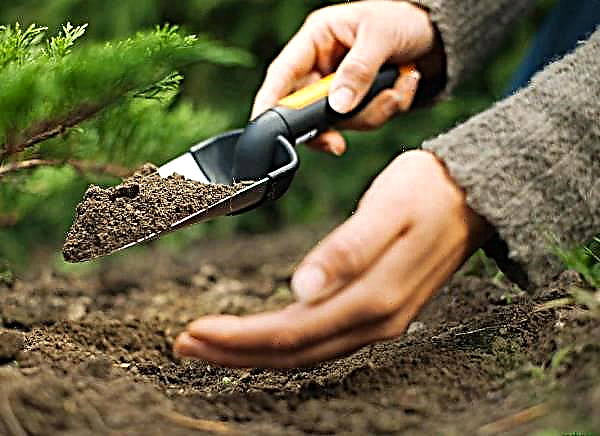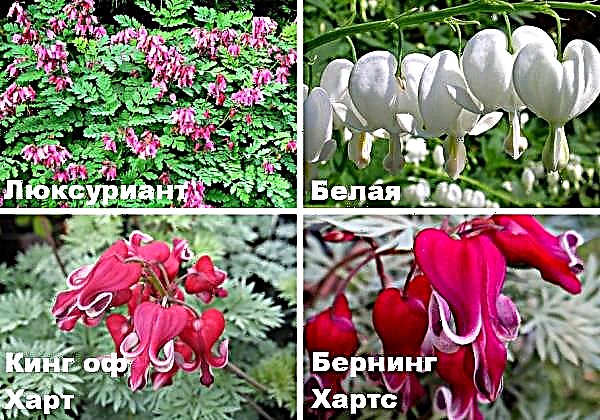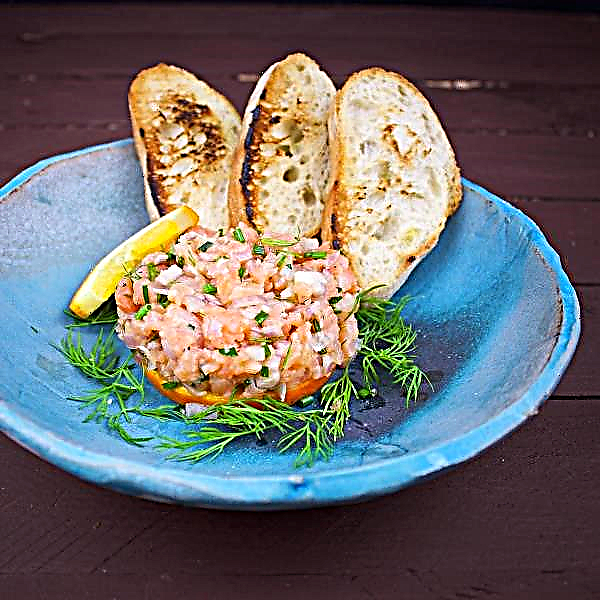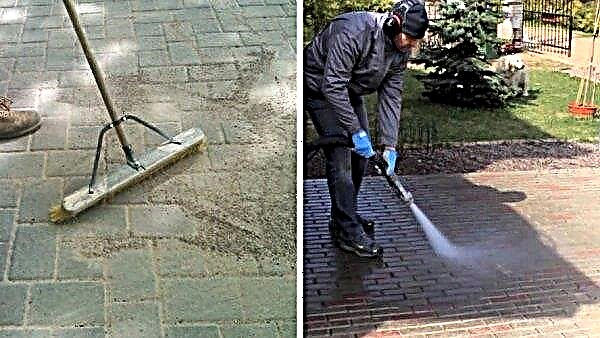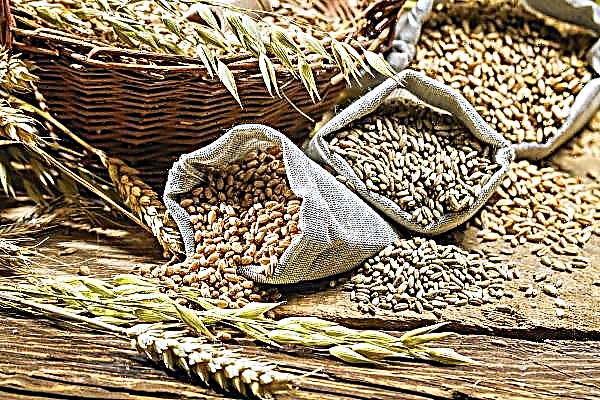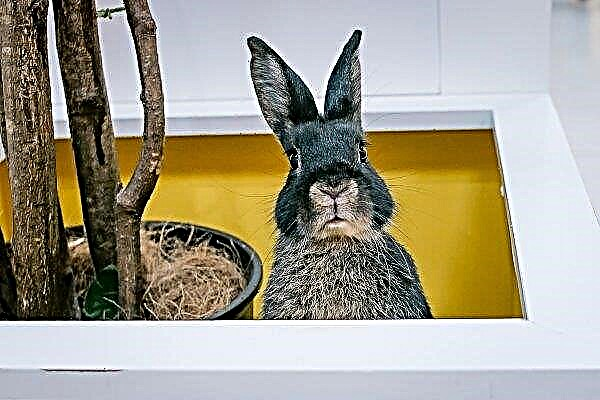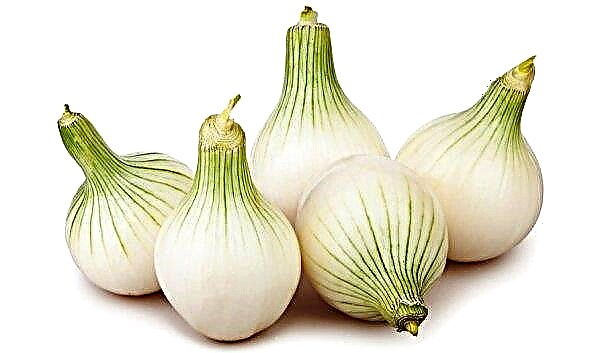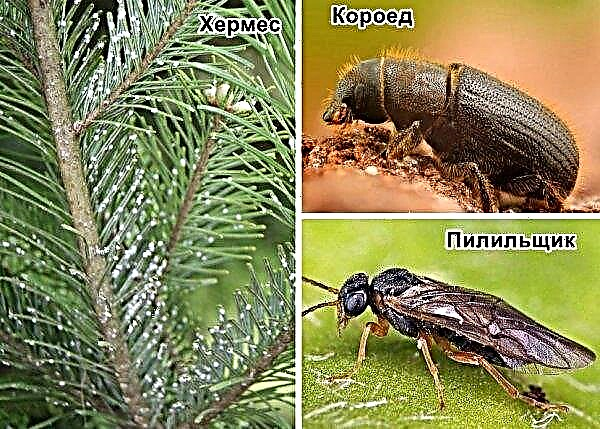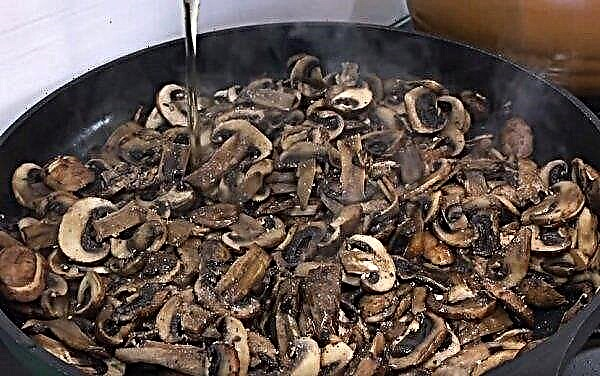Coniferous plants can decorate any site. Today there is a huge assortment of spruce and pine species, varieties, forms, from which you can choose a tree for planting in almost any locality. Canadian spruce, which is often confused with pine, is especially popular. The technology of its cultivation will be discussed in the article.
Tree description
Canadian spruce (Picea glauca) grows to a maximum height of 20 m. Occasionally in the wild you can find specimens of 40 m each. The tree trunk reaches a diameter of 1 m. In young plants, the crown forms in the form of a narrow cone. In mature spruce, it becomes cylindrical.
The trunk is covered with a thin scaly bark. The needles grow in length by 1.2–2 cm. Its upper part is painted in blue-green color, the lower - in blue-white. Cones are formed in the form of cylinders 3–7 cm long and 2.5 cm wide. They are green in color, sometimes reddish. As they mature, they turn brown.

The growing season at the tree begins in April. Annual growth is 15–28 cm. Dusting begins at the age of eight. It lasts 6-8 days.
- The described variety is appreciated because of such characteristics:
- high level of decorativeness;
- a large assortment of varieties and forms, including dwarf ones;
- drought tolerance;
- unpretentiousness to the composition of the soil.
Canadian spruce is also known by other names - gray, white. The people also often call it Canadian pine, although, according to the classification in botany, this is not true. Spruce and pine are closely related plants that belong to the same family - Pine, but at the same time are assigned to different genera.

Breeders bred several varieties and forms of Canadian spruce. Among them are dwarf plants, as well as trees with interesting colors of needles. To make a choice, you must familiarize yourself with their description and preferences.
Did you know? The oldest spruce, 9550 years old, was given the name Old Tikko. It belongs to the European species and grows in the territory of the Fulufjallet National Park in Sweden.
Konica. The most famous and popular variety of Canadian spruce. It was found in Canada in 1904. Trees of this variety do not exceed 2.4 m in height. Crohn can form in the form of a pin or cone. It is characterized by density. Reaches a diameter of 1.5 m.
The needles, when they appear, are painted in a saturated green color. It gets dark later. The length of the needles is 1–1.5 cm. Konika trees are characterized by slow growth, high winter hardiness, and lack of dusting.
 Gardeners and landscape designers appreciate them for the beautiful shape of the crown, which does not require shaping with a haircut
Gardeners and landscape designers appreciate them for the beautiful shape of the crown, which does not require shaping with a haircut
Alberte Globe. The variety appeared as a result of a natural mutation and was discovered in the Netherlands in 1967. Trees grow 1 m in height and 1 m in diameter. The crown is formed in the form of a ball. The branches of the spruce are short. They are densely arranged in a radial order.
Cones are small, light brown, grow at the ends of shoots. Needles are characterized by softness, decorativeness. A pleasant aroma emanates from it. Young needles are painted in yellowish shades, as they grow older they darken and acquire a saturated green color. The tree grows slowly - in a year it adds 10 cm in height and 2-4 cm in width.
Video: Canadian fir Alberta Globe
Nana Representatives of this variety grow low and do not exceed 1 m in height. They form a lush, rounded crown with a maximum diameter of 80 cm. The needles are located radially. Each needle grows in length by 0.7–0.8 cm. Needles are characterized by stiffness. It is painted in a beautiful blue-gray color.
 The Nana tree grows slowly - in a year it can add 4-6 cm in growth
The Nana tree grows slowly - in a year it can add 4-6 cm in growth
Landscape design application
Canadian spruce is planted as a tapeworm and in group compositions. Dwarf trees are well suited for rocky slides. They are also often planted at the entrance to the gazebo, on the terrace, in the stalls, front gardens, rabatki. These plants look great along the shores of artificial reservoirs.
If we talk about a successful combination, then Canadian spruce can be grown next to other coniferous crops, especially with different shades of needles. It is also good to plant them next to deciduous plants, for example, birches.
A low-growing variety of Konik is planted alone in the foreground of a decorative composition, on a trimmed lawn. It is suitable for group plantings, in combination with boxwood, barberry. A short tree can be grown in a container and used as a New Year attribute.
Alberta Globe trees are ideal for decorating oriental-style gardens, as well as heather, rocky. They can be combined with ornamental shrubs and perennials, grown in a pot.
Representatives of the Nana variety are recommended to be planted on the lawn, in rock gardens. They are suitable for cultivation in city parks, squares, alleys.

Growing regions
The birthplace of Canadian spruce is North America. There it grows throughout the territory, from north to south. It is a symbol of the province of Manitoba (Canada) and the state of South Dakota. More than 300 years ago, spruce was introduced to Europe, where today it is common in many countries. Later it began to be planted in Central Asia, China.
The Canadian variety is suitable for cultivation in most regions of Russia, in Ukraine, Belarus.
How to plant
In order for the spruce to grow healthy, strong and beautiful, it must be planted correctly. Preparation for landing should begin with the selection of a successful site. Representatives of the Canadian varieties of conifers prefer to grow in well-lit areas, sheltered from drafts.
The described coniferous culture will grow well and show maximum decorativeness when planting in rich loamy water-intensive soils. The tree does not feel well in depleted soils with a high content of lime.
Video: How to plant a coniferous plant
You should not choose areas in the shade, since in this case the decorativeness of the plant will be significantly reduced, it will slowly grow and develop. It can also lead to the fact that the culture begins to dry and hurt.
Since the root system of the plant grows in breadth, and not in depth, you should be careful to the nearest building, a fence or another tree, shrub, a distance of at least 2.5 m was maintained.

Landing can be scheduled for April or September. It is very important that at the time of planting a seedling, warm weather is already established. If there is still a risk of return frosts, it is better to postpone the landing until a later time.
The seedling should be purchased in a container. Such a plant will grow faster and grow stronger in open ground. Landing should be carried out by transshipment, making sure that the earthen lump is not destroyed. If the roots are not intentionally exposed, they should be treated with a rooting agent, for example, “Kornevin” or “Heteroauxin”.
Important! When planting a spruce seedling, it should be controlled so that the root neck is placed at the same level with the soil surface.
Planting spruce is as follows:
- For 2-3 weeks before planting, dig a planting hole with a depth of 50–70 cm or 1.5–2 times the container in which the seedling grows.
- Mix the soil mixture of turf, leaf soil, peat, sand in a ratio of 2: 2: 1: 1.
- At the bottom of the pit lay a drainage layer 15–20 cm high of broken brick, coarse sand.
- A day before planting, it is good to water the seedling.
- Remove the plant from the container.
- Put an earthen lump in the center of the pit.
- Fill the hole with prepared soil mixture to the top.
- Dig a shallow groove along the entire diameter of the trunk circle, retreating 20–25 cm from the trunk.
- Slowly pour 10 liters of water into it.
- Lay a layer of mulch from pine bark or peat around the trunk.

Spruce can be propagated in two ways: vegetative and seed. The second method at home is rarely used due to the length and troubles of the process. Seeds should be stratified for 1-2 months and further germinated. Such plants are planted in open ground only a year later.
When propagating fir trees at home, they mainly use cuttings. Planting material is harvested in early June, when the growth of branches stops. Cuttings are cut from one- or two-year-old well-lignified side shoots with at least one sleeping bud.
Important! When harvesting the cuttings, they must be separated with a piece ("heel") of the mother plant. Otherwise, the plant will not take root.
The size of the planting material is 10-12 cm. Before planting for rooting, the ends of the cuttings are dipped into the root. Then they are planted in a soil substrate to a depth of 2–2.5 cm. After planting, they are sprayed and covered with a film, creating the conditions of a mini-greenhouse. After rooting, transplanted to a permanent place.

Care Rules
Canadian spruce is an unassuming plant. It is able to grow well with minimal human involvement. However, you still need to take care of the tree - this will allow you to fully reveal its decorativeness, prevent health problems.
The main events that are required to be held annually:
- watering
- fertilizer application;
- loosening;
- weeding;
- mulching;
- preventive measures against diseases and pests.
Video: General tips for caring for conifers
Watering
Be sure to water the young plants. During the period of rooting and adaptation in the soil, they need enough moisture. Under one plant spend up to 10 liters of water. Moisturize the plant is 1 time per week. As rooting, the frequency of watering is gradually reduced. Mature plants are watered only in case of long dry periods.
 The spruce trees respond well to such a procedure as sprinkling - watering the crown from the hose with a diffused stream. It allows you to moisturize the plant and wash away dust and pollution from it. If a tree is planted within the city, then such irrigation is recommended every week.
The spruce trees respond well to such a procedure as sprinkling - watering the crown from the hose with a diffused stream. It allows you to moisturize the plant and wash away dust and pollution from it. If a tree is planted within the city, then such irrigation is recommended every week.
Top dressing
Fir trees do not need obligatory top dressing. They can be made if necessary and at will, in order to improve growth, decorativeness, and strengthen immunity. Thinking about fertilizing should not be earlier than 2 years after planting. Until this time, the young spruce will spend those minerals that were introduced into the planting pit.
For fertilizing coniferous plants, universal fertilizers are suitable, for example, Kemira-Universal or specially designed for coniferous crops: Uniflor, Agrecol, etc. Organics for feeding spruce do not use.

Mulching and loosening the soil
After each moistening, rain and weeding, the soil around the tree trunk must be loosened. Since the roots of the spruce occur in the surface layer of the soil, this procedure should be performed with special care so as not to harm them. The recommended depth to which it is allowed to loosen the soil is 5–7 cm.
Loosening will make the soil softer, remove a dense crust from the surface, which prevents the normal flow of moisture and air to the root system.
Did you know? Spruce has a very valuable wood that conducts sound well. The famous Italian string instrument master Antonio Stradivari used it to make the upper decks of his unique violins.
Another important procedure that simplifies care is mulching. Once or twice a year, the ground in the near-stem circle needs to be covered with mulch from sawdust, pine bark, wood chips, peat. These materials will help maintain the optimum level of moisture in the soil and carry out watering much less frequently. Also, this procedure leads to restraint of weed growth, a decrease in the number of cultivations and weeds. Mulch needs to be laid in a layer 5–9 cm high. Before winter, to warm the roots, it should be increased to 20–35 cm.

Haircut and trim
Pruning of trees is carried out for two purposes: sanitary and formative.
Canadian spruce does not need crown formation. It is capable of naturally forming a symmetrical, regular-shaped crown. It is necessary to cut the plant only if the project plans to create from it some other geometric figure, and not a cone.
Sanitary scraps should be performed annually. In the course of them, damaged, frostbite, diseased, shrunken, yellowed branches are cut out. The shoots must be removed exclusively with a disinfected tool. Slices should be treated with copper sulfate or another disinfectant. It’s not necessary to cover garden varieties with RanNet - the fir trees produce a large amount of resin, which can quite cope with the rapid healing of wounds.

Winter preparations
Canadian spruce has a high level of frost resistance. Therefore, shelter for the winter is needed only by young plants, whose root system has not yet been sufficiently strengthened, and the shoots are not completely lignified. To cover the trees, use burlap, agrofiber. Roots protect with a high layer of mulch.
In regions where heavy snowfalls are observed, in order to protect the branches from damage, they are tightly tied to the trunk.
At any age, the first spring rays of the sun are dangerous for spruce. They can burn needles and significantly damage the decorative tree. therefore in February it is necessary to organize sheltering of the crown with materials that do not allow sunlight. Such protection should be on the tree until April.

Diseases and Pests
Spruce has a strong immunity. If you plant it correctly and give it at least minimal care, then most likely the owner of the site will not have to deal with such a troublesome process as the treatment of diseases and pests.
To prevent problems with the growth and development of the plant, it is necessary to resort to preventive measures, among which the following are mandatory:
- regular inspection of the tree;
- cleaning the site of plant debris in the fall;
- deep digging of the soil in the near-stem circle;
- double spraying of the crown in the spring and autumn with preparations containing copper.
If the plant begins to wither away, its needles turn yellow and fall, the shoots dry out, the disease or pest should be determined and treatment should be started in a timely manner. The following table can help deal with symptoms and choose treatment methods:
| Disease name | Symptoms of infection | Treatment methods |
| Root rot |
|
|
| Schütte ordinary |
|
|
| Rust |
|
|
Malicious insects can cause serious damage to the conifers, leading to a partial or complete loss of decorativeness and even death. The fight against parasites should begin in a timely manner, while their population on the tree is still insignificant.

The following table will tell you how to deal with pests:
| Insect name | Symptoms of lesion | Treatment methods |
| Spruce false shield |
| The use of insecticides with a wide spectrum of action, for example, "Enzhio", "Calypso", "Actara". |
| Spider mite |
|
|
| Aphid |
|
|
| Spruce hermes |
| Crown treatments with systemic insecticides, for example, Calypso, Caesar. |
To summarize the above, it should be noted that Canadian spruce is a very beautiful plant that retains a decorative appearance throughout the year. Having picked up a favorite and suitable variety, you can decorate them with the most modest in size cottage, garden, garden plot. Planting a tree is easy even for a beginner. A cultivation of the plant requires minimal participation from the owner of the site.

